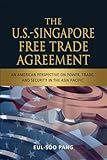The U.S.-Singapore Free Trade Agreement : An American Perspective on Power, Trade and Security in the Asia Pacific / Eul-Soo Pang.
Material type: TextPublisher: Singapore : ISEAS Publishing, [2011]Copyright date: ©2011Description: 1 online resource (328 p.)Content type:
TextPublisher: Singapore : ISEAS Publishing, [2011]Copyright date: ©2011Description: 1 online resource (328 p.)Content type: - 9789814311991
- 9789814345002
- 382.95957073 382/.97305957
- HF1756
- online - DeGruyter
| Item type | Current library | Call number | URL | Status | Notes | Barcode | |
|---|---|---|---|---|---|---|---|
 eBook
eBook
|
Biblioteca "Angelicum" Pont. Univ. S.Tommaso d'Aquino Nuvola online | online - DeGruyter (Browse shelf(Opens below)) | Online access | Not for loan (Accesso limitato) | Accesso per gli utenti autorizzati / Access for authorized users | (dgr)9789814345002 |
Frontmatter -- Contents -- List of Tables -- Foreword -- Message -- Preface -- Acknowledgements -- Introduction -- 1. On the Crest of Trade and Globalization: Singapore and America -- 2. The Road to the United States-Singapore Free Trade Agreement -- 3. American International Trade Practices: History and Theory -- 4. The USSFTA Bridging Economic Regionalism and Security Regionalism -- 5. The American Politics of FTAs, Lobbying, and Domestic Reforms -- 6. A New Strategic Relationship in the Western Pacific: Asia’s Preferences and America’s Choices -- Conclusion -- List of Abbreviations -- References -- Index -- About the Author
restricted access online access with authorization star
http://purl.org/coar/access_right/c_16ec
Free trade has become the mantra of development strategy for many countries in the world, especially those in the Asia Pacific. This book delves into the American side of the story. It is about how Singapore and the United States came to sign the agreement in 2003 (taking effect from 1 January 2004). The United States - Singapore Free Trade Agreement (USSFTA) is the first FTA that America signed with an Asian country and the second such agreement with a fully developed country, after Canada. The city-state has used a free trade agreement as both a national survival and a growth strategy, first forging such FTA ties with its major trading partners and then expanding its strategic link to such extra-regional great powers as the United States, Japan, Australia, China, India, and the European Union. Both Singapore and the United States saw in FTAs something more than just merchandise trade. After 9/11 and the invasion of Iraq, the Bush administration linked granting trade preferences to security policy. Instead of using FTAs as a tool to reduce the ballooning trade deficit and to forge FTAs with such major trading partners as China, Japan, and the European Union, the Bush administration politicized the FTA process by going after smaller economies in order to garner their support for its global security strategy. Single-issue special interest groups and acrimonious partisanism in the U.S. Congress have diluted the principle of free market and competition. But the book argues that the USSFTA is an exception to this rule because the partners are fully developed economies. The book also questions whether such high "WTO-Plus" gold standards that the two partners have embraced can easily be replicated elsewhere.
Mode of access: Internet via World Wide Web.
In English.
Description based on online resource; title from PDF title page (publisher's Web site, viewed 01. Dez 2022)


